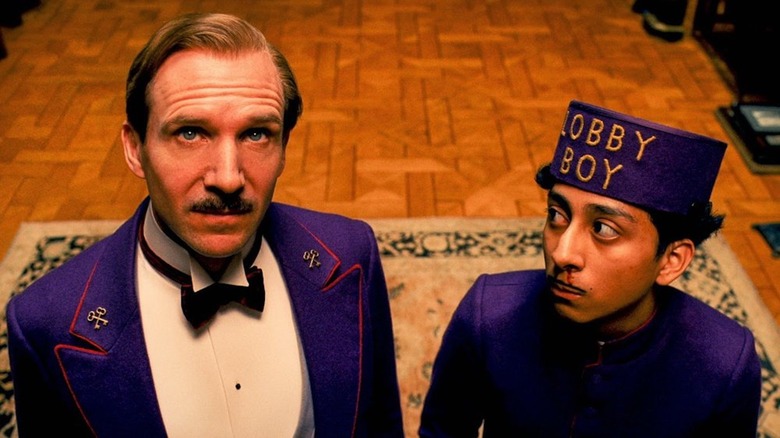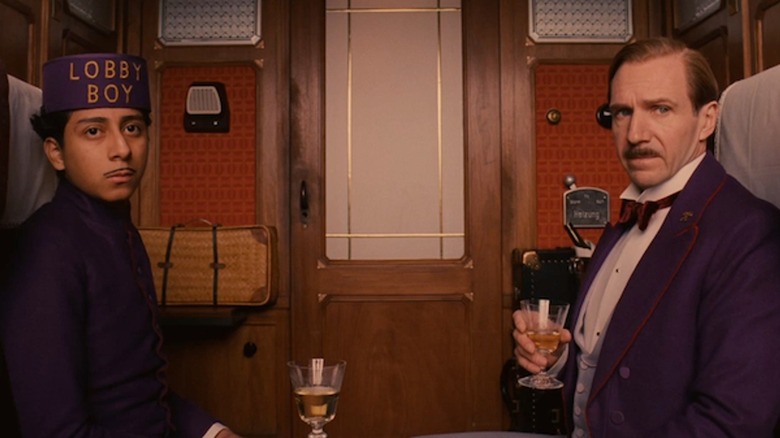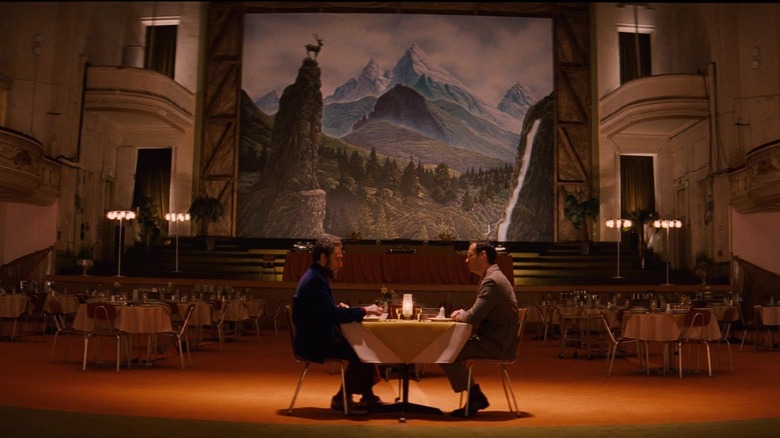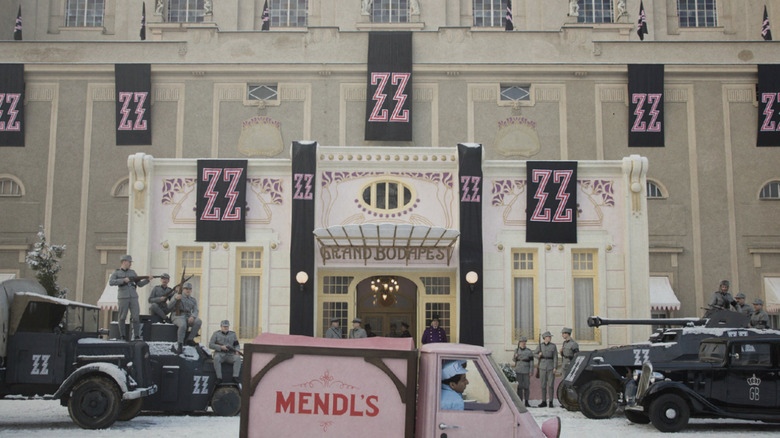The Grand Budapest Hotel Ending Explained: An Enchanting Old Ruin
"The Grand Budapest Hotel" is Wes Anderson's apotheosis, the film which is key to understanding his artistry. Indeed, his most recent film, "The French Dispatch," feels like a mere echo of "Grand Budapest."
His most visible trademarks are there. Every regular from his troupe of actors (Owen Wilson to Jason Schwartzman, Willem Dafoe to Bill Murray) show up for parts large and small. The tone is deadpan comedy with tragedy sprinkled in. Anderson's filmmaking is quirky yet precise; he prefers center framing and adorns his shot subjects with exaggerated costume and set design. "Grand Budapest" includes all that and, combined with the use of miniatures, it looks like it was filmed in Anderson's own personal dollhouse.
Beneath the beauty and the hilarity, though, what does it all mean?
The film is the story of the eponymous, fictional hotel in the equally fictitious country of Zubrowka (named for a Polish Vodka brand). Though the story and setting is fictional, the film's inspirations weren't. As /Film has reported, Zubrowka was modeled on sights Anderson observed in the Czech Republic. The film also credits novelist Stefan Zweig as an inspiration.
The central character is the hotel's owner, Zero Moustafa (Tony Revolori plays him as a young adult, F. Murray Abraham when he's reached his elder years). The decline of the hotel from Zero's youth to the present is linked with the deteriorating state of society. However, the film avoids being a simple yearning for the good ol' days by showing the dark side of nostalgia too.
A story within a story within a story
"The Grand Budapest Hotel" is not a mere story-within-a-story. No, it has three framing devices, each one leading into the next. In the present, a young woman (Jella Niemann) visits the grave of an acclaimed Zubrowkan Author, who seems to be a stand-in for the aforementioned Zweig. Observing his shrine of a grave marker, she reads one of his works: "The Grand Budapest Hotel."
To visualize what the girl's reading, we see the Author (Tom Wilkinson) writing the book in 1985; he speaks his words aloud from behind a desk. As the Author tells it, in 1968, his younger self (Jude Law) visited the eponymous hotel and met the aged Zero. Zero tells the author the tale of how he acquired the hotel over dinner. The deepest layer of flashbacks (which take up most of the film) are set in 1932, when the hotel was at its prestigious prime. The younger Zero worked as a lobby boy under concierge Monsieur Gustave H. (Ralph Fiennes) and got swept up in a misadventure involving murder and a invaluable painting.
Since we barely spend any time with Wilkinson's iteration of the author and never even learn the girl's name, you might ask — why so many layers? Anderson wants not just to depict Zero's story, but show how it survived. Wilkinson's Author explains:
"Once the public knows you're a writer, they bring the characters and events to you, and as long as you maintain your ability to look and to carefully listen, these stories will continue to... seek you out over your lifetime."
That's a responsibility of writers, to pass down stories through generations and ensure they live on.
Everything fades away
When the author visits the hotel, it's decline is visible; compare the exterior shots of the Hotel in 1932 (lavish and pink) with it in 1968 (dull and grayed). Indeed, every framing device employs a distinct palette and aspect ratio to reflect the changing times. In the 1932 storyline, the main color onscreen is pink, giving the film a whimsical, almost child-like feel. By 1968, the primary color in the palette has gone from pink to orange; the sun is setting on the Grand Budapest.
Even so, it's revealed that Zero gave up his fortune to retain ownership of the hotel? Why? It's his last link to his late wife Agatha (Saoirse Ronan) and the happiness they briefly shared.
The closing lines of the film is the Author lamenting the eventual demolition of the Grand Budapest: "It really was an enchanting old ruin, but I never managed to see it again." As his words flow, the story jumps forward through time until we return to the girl sitting by the Author's book, having finished it. The stones of the Grand Budapest were swept aside, but the memories of it weren't.
Dark side of nostalgia
The disrepair of the Grand Budapest is as emblematic of civilization's own decline. The concierge in 1968, M. Jean (Jason Schwartzmann), is a poor replacement for Gustave, who was a perfect gentleman and taught Zero to be the same. Gustave belongs to a group of concierges called the Society of Crossed Keys (named for a Zweig book), whose mission is preserving the traditions of good manners. Their efforts, however, mean little in the end. In his last conversation with the Author, Zero laments, "I think [Gustave's] world had vanished long before he ever entered it."
Indeed, things are not well in 1932 Zubrowka. While the film is set in a pastiche of Europe, the political environment mirrors the real time and place. The fascist "Zig-Zag Division" is on the rise, with a double-Z insignia standing in for Nazi Swastikas. Among the Zig-Zag members are the film's villains Dmitri (Adrien Brody) and Jopling (Willem Dafoe), who frame Gustave for the murder of his mistress/Dmitri's mother Madame D. (Tilda Swinton).
By the last scene of the 1930s section, the Zig-Zags are in power in Zubrowka. In another case of color reflecting mood, the film shifts to black and white. Under fascist rule, the color of life has vanished from Zubrowka. The regime's policemen harass Zero for being an immigrant and kill Gustave when he defends his protégé. Gustave's death, as it turns out, is how Zero, his heir, came to wealth. Still, even by 1968, he mourns the death of one of the last "faint glimmers of civilization left in this barbaric slaughterhouse that was once known as humanity."
Fascism, an ideology of returning to an idealized past, destroys everything good. Unless traditions go hand in hand with decency, they're not worth clinging to.



